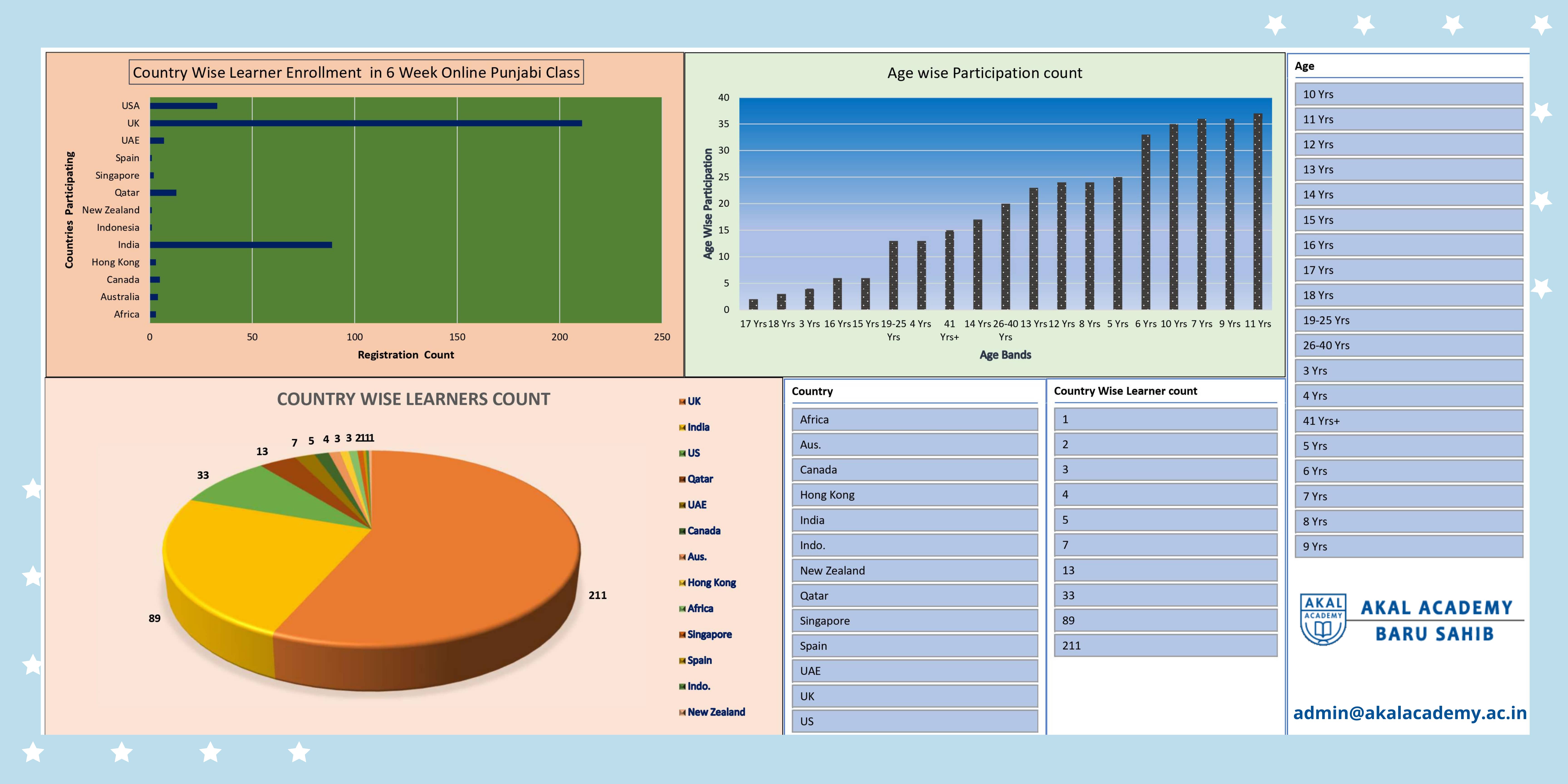Learning in CAIE
Cambridge Assessment International Education
Your child’s needs as a learner are at the heart of Our approach to education. Our Cambridge Programme aims to give your child a love of learning that will stay with them through school, university and beyond.
Cambridge Assessment International
Education (CAIE)
Let the education open your mind and heart
At Akal Academy Baru Sahib,
our Cambridge Assessment International Education programme adopt
‘active learning’ as our classroom approach. This acknowledges that
our learners are active in the learning process by building
knowledge and understanding in response to learning opportunities
provided by their teacher. This style of learning contrasts with a
model of instruction whereby knowledge is imparted or transmitted
from the teacher to students.
Active learning primarily
includes:
Student-centred learning - Students play an active role in their
learning, with the teacher as an activator of learning, rather than
an instructor
Enquiry-based learning - Students learn by addressing and a posing
scientific questions, analysing evidence, connecting gs such
evidence to prior theoretical knowledge, drawing conclusions, and
reflecting upon their findings
Experiential learning - Learning takes place through direct
experience. Learning should be relevant and situated within a
meaningful context. We learn best when we can see the
Learning is developmental. Learning experiences for children, therefore, should be age-appropriate although development level and age are not always concurrent.
APPROACH BRIGHTER AND HAPPIER CHILD
Cambridge Assessment
International Education(CAIE) prepares school students for life,
helping them develop an informed curiosity and a lasting passion for
knowledge.
The Cambridge Pathway gives students a clear path for educational
success from age 5 to 19 through, Cambridge Primary, Cambridge Lower
Secondary, Cambridge Upper Secondary and Cambridge Advanced
programmes. At Akal Academy Baru Sahib, we offer Cambridge Upper
Secondary and Cambridge Advanced programme, shaping the curriculum
around a wide range of subjects and using flexible ways to offer
them. It helps our students discover new abilities and a wider
world, and gives them the skills they need for life, so they can
achieve excellence at school, university and professional world.
Our ‘Learner-centered’ teachers set their teaching in real world
contexts; finding out learners’ starting points of understanding
before they plan how to enable them to learn. Because of this, a
learner-centred teacher will focus on differentiation, and will use
strategies associated with assessment for learning, including:
➤ effective questioning
➤ sharing of assessment criteria
➤ provision of feedback
➤ peer assessment and self-assessment
➤ using assessment information to adapt their teaching methodology
The Cambridge approach supports us to develop learners who are
confident of ideas and information that they have learnt or
gathered. Such learners are also respectful of others ideas and
perspectives. They have ability to innovate, engage socially and
intellectually with new environment so as to make distinct
contribution in any field of endeavors,
Brief of Online Language Class
 Glimpses of the Online Punjabi Class revealed the eagerness of both children and parents to learn Maa Boli Punjabi. Over 150 kids attended the 10-day online class, which ran from 19th July to 27th August 2021.
Glimpses of the Online Punjabi Class revealed the eagerness of both children and parents to learn Maa Boli Punjabi. Over 150 kids attended the 10-day online class, which ran from 19th July to 27th August 2021.
Akal Academy Baru Sahib, under The Kalgidhar Trust, offered six weeks of online Punjabi classes aimed at enhancing confidence in reading, writing, and speaking Punjabi. The course, attended by over 350 students from 13 countries, provided an enriching learning experience.
The excitement of learners of all ages, along with their parents' enthusiasm, was heartwarming as they embraced the opportunity to learn Punjabi, their mother tongue.
The Cambridge IGCSE programme helps students to acquire knowledge, understanding and skills in the subject they study through intellectual enquiry and intellectual enquiry. The Cambridge IGCSE programme has been designed for students worldwide, including those whose first language is not English.
With the Cambridge Pathway, your child is joining a global community of learners from more than 10 000 schools in over 160 countries. By developing a global outlook in Cambridge learners, we aim to equip them for success in the fast-changing modern world.
A Cambridge IGCSE qualification is recognised by leading universities around the world and employers view it as a valuable certificate of achievement. In the UK, Cambridge IGCSE is accepted as equivalent to the GCSE. A good grade (grade C or above) in Cambridge IGCSE English as a Second Language is accepted for entry by a number of universities in the UK as evidence of competence in the English language.
Many universities worldwide require a combination of Cambridge IGCSEs and Cambridge International A Levels to meet their entry requirements. Leading US and Canadian universities require Cambridge International AS& A Levels, but some US and Canadian colleges and universities will accept students with five Cambridge IGCSEs at grade C or above.
Cambridge assessments do not simply test recall of knowledge but also tests learners ability to draw on their understanding in order to analyse, evaluate and synthesise ideas. In this way, Cambridge programmes and qualifications are best taught using active learning approaches which are also more engaging for students. Encouraging active learning enables learners to attain higher grades, based on their enhanced understanding, and better prepares them for further education and as well as for the workplace.
Every year, nearly a million Cambridge learners from 10 000 schools in over 160 countries prepare for their future with an international education from Cambridge.
Cambridge has a 150-year history of providing international exams. It is a not-for-profit organisation and the only exam board wholly owned by aworld-leading university.
Every student admitted to the school pledges to observe willingly
all the Rules and Regulations and to uphold and respect the
principles on which the institute is founded. It is also to be
understood that on breaking the pledge, the student forfeits his /
her membership of the school. It is the duty of each student to
perform all tasks assigned to him/her in connection with the
functioning of the school to the best of his/her ability.
All Sikh students are required to follow the Sikh spiritual and
religious way of life being taught at the school. They have to keep
their hair intact and are not allowed to cut hair from any part of
their body.Any deviation from the Sikh religious principles,
especially the cutting of hair, will lead to strict action and
punishment which may lead to expulsion. The students are motivated
to prepare themselves for partaking Amrit (through the Sikh way of
baptism) at an appropriate age during their study period in the Akal
Academy which would provide them better divine wisdom and value
based education
Any indiscipline on the part of a student may lead to his/her
removal from the school rolls. The decision of the President of the
Kalgidhar Trust / Society, in such cases, shall be final. Legal
Disputes, if any, shall lie within the jurisdiction of the District
where the Academy is located.
BULLYING IS STRICTLY PROHIBITED
Bullying has severe
detrimental effects on those who are bullied. The effects can be
immediate. They can also be long-term and can cause lifelong damage.
In every bullying situation, there are typically three key parties:
the victim, the bully or bullies, and those who stand by
(by-standers), who are aware of the bullying. Each of these three
parties is affected negatively by bullying.
The responsibility of preventing any undesirable aspect of bullying
and ragging rests jointly and also individually on all stakeholders,
which includes the head of the institution teacher, non-teaching
staff, students, parents and local community.
Bullying is strictly prohibited inside the school premises and no
such act will go unnoticed or unpunished.
The methods of intervention are as important as methods of
prevention. Following actions and penalties may be taken by the
School Management as per observation and understanding the gravity
of the misconduct:
(i) Oral/written warning.
(ii) Suspension from attending classes/school for a specified
period.
(iii)Withholding or cancelling the results.
(iv) Imposition of fine upto a specified amount.
(v) Expulsion/rustication from school in case of high severity of
the misdemeanour.
(vi) Transferring a student from one school to another school.
RAGGING IS PROHIBITED
Bullying has severe
detrimental effects on those who are bullied. The effects can be
immediate. They can also be long-term and can cause lifelong damage.
In every bullying situation, there are typically three key parties:
the victim, the bully or bullies, and those who stand by
(by-standers), who are aware of the bullying. Each of these three
parties is affected negatively by bullying.
The responsibility of preventing any undesirable aspect of bullying
and ragging rests jointly and also individually on all stakeholders,
which includes the head of the institution teacher, non-teaching
staff, students, parents and local community.
Bullying is strictly prohibited inside the school premises and no
such act will go unnoticed or unpunished.
The methods of intervention are as important as methods of
prevention. Following actions and penalties may be taken by the
School Management as per observation and understanding the gravity
of the misconduct:
(i) Oral/written warning.
(ii) Suspension from attending classes/school for a specified
period.
(iii)Withholding or cancelling the results.
(iv) Imposition of fine upto a specified amount.
(v) Expulsion/rustication from school in case of high severity of
the misdemeanour.
(vi) Transferring a student from one school to another school.









